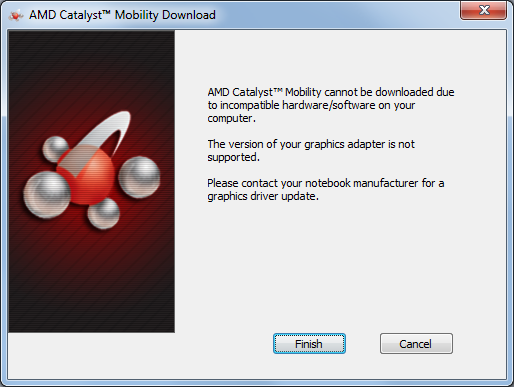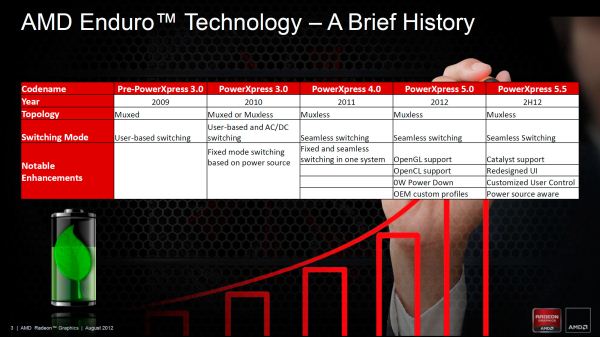AMD’s Enduro Switchable Graphics Levels Up
by Jarred Walton on September 6, 2012 3:00 AM ESTRecap: AMD’s PowerXpress, aka Dynamic Switchable Graphics, aka Enduro
Getting back to the switchable graphics, AMD has gone through a variety of names over the years. Here’s AMD’s summary slide, which I’ll discuss in detail:
Originally introduced as PowerXpress back in 2008, the first AMD switchable graphics solutions were like that found later in the ASUS UL80Vt and similar laptops: you had to flip a switch, and in the first iterations you would then need to reboot the laptop so that the BIOS could disable the discrete GPU and activate the integrated GPU. It was messy and a bit inconvenient, and NVIDIA’s early studies showed that many users ended up not using the feature—they would either run on dGPU all the time or on iGPU all the time. Both AMD and NVIDIA had a second series of switchable graphics designs where the need to reboot was removed; the first Alienware M11x could switch GPUs in about 10-15 seconds, and the same was true of HP’s first ENVY laptops. These were using PowerXpress 2.0 and 3.0, and for most people the switching side was adequate: you’d run on dGPU when plugged in and switch to iGPU when on battery power.
Last year, AMD took a step forward with their switchable graphics by introducing PowerXpress 4.0, which also renamed the technology to Dynamic Switchable Graphics (DSG for short). I got a chance to do a head-to-head of the technology using a Sony VAIO C laptop provided by NVIDIA. You know a company is confident that they’re going to win a technology comparison when they’ll actually give you a competitor’s product. In some cases, DSG was just as good as Optimus: you could launch a supported game and never realize all the extra stuff happening in the background; unfortunately, there were several titles where it wasn’t quite as convenient as we would have liked, and OpenGL support from DSG was completely missing.
Step forward to early 2012 and we got another update to PowerXpress 5.0 (note that PowerXpress is now only used internally by AMD and hasn’t been their marketing name since before PX4.0) along with a rechristening: Dynamic Switchable Graphics was out and Enduro was in. If nothing else, at least it makes my job easier as Enduro is much more concise. There's also the fact that the GPUs are no longer "switching", as the iGPU is always running; now the dGPU is simply supplementing the iGPU when needed. Along with the name change, AMD added OpenGL and OpenCL support to the mix, and with their Zero Core Technology (which is also part of their 7000 series desktop GPUs—a case of mobile design influencing desktops) the need to keep a small portion of the chip alive (aka BACO: Bus Active Chip Off) was removed. OEMs could also ship with custom profiles for applications, so for example Dell might want all of their extra utilities to default to running on the iGPU.

Hopefully this problem goes away next month!
Other than those changes, the UI and driver updates situation on early Enduro solutions remains largely the same as with DSG/PX4.0—and that’s what I initially received with the Clevo P170EM, with drivers from around March 2012. A quick check at AMD’s site also let me know that there weren’t any new drivers available, as the P170EM wasn’t currently supported by the latest Mobility Catalyst drivers.











200 Comments
View All Comments
Montage - Thursday, September 6, 2012 - link
So you mean the APUs can currently max Battlefield 3 and Crysis 2? How about Civ5 or Total War Shogun 2? Them APUs still got a long way to catch up with dGPUs.sirizak - Thursday, September 6, 2012 - link
Yeah this is rubbish, APU's are not going to be upto the task in a true gaming laptop for a long time yet. This is not an APU kit, at $2000+ it should give desktops a run for their money.arcticjoe - Thursday, September 6, 2012 - link
as Montage have said, there AMD's apus are very far behind in performance compared to current laptops with switchable graphics.silverblue - Thursday, September 6, 2012 - link
I'm not sure what Beenthere is smoking, but APUs are only meant to replace low to mainstream dGPUs. They're hardly a performance option. An APU-based system should reduce cost and power consumption but it's not the messiah for the more serious gamer.There will always be somebody who wants the latest and greatest, and if NVIDIA can provide the support for this, why can't AMD?
JarredWalton - Thursday, September 6, 2012 - link
It's Beenthere guys. Go read his other pro-AMD, anti-Intel comment on Ivy Bridge and Trinity mobile articles if you don't know why he's not worth feeding. ;-)hulawafu77 - Thursday, September 6, 2012 - link
AMD's APU is a pitiful solution compared to Intel Ivey Bridge + Nvidia 680M. Your suggestion is not even remotely comparable. Not even in the same stadium for performance.hmoobphajej - Thursday, September 6, 2012 - link
Their APU isn't suppose to be a solution to discrete CPU + GPU. They're a all around solution to mobility that offers a adequate performance for computation and graphics. They're for the main stream users that don't want to play BF3 on ultra or any other demanding games in particular. The APUs are more or less aimed at what mainstream buyers would want; which is a computer for daily use, good battery life, smaller form factor, and a cheaper price. Not somehting a enthusiast gamer would want... which is a desktop.sirizak - Thursday, September 6, 2012 - link
I've been following this for awhile now, I almost bought a 7970m gpu'd P150EM a month ago due to the pricing vs the 680m. I am still waiting to purchase this laptop. In Australia I can get one specced with 7970m for under $2000, GTX 680m is $2300, I have told lovely that I will come in under $2000.Until this the Enduro under utilization issue is resolved I will not buy this laptop, it is that simple. Otherwise it ticks all my boxes, quality matte screen, backlit keyboard, plenty of CPU and SSD choices, and an unobtrusive exterior. I believe there may also be issues with the headphone outputs of the P150EM. Thats not AMDs issue but another cross against this setup.
This is not cheap kit, if you cannot get this sorted please pull the product, it's a disgrace and ruining not only AMDs reputation but also the reputation of all the Clevo resellers. ie. Metabox in Oz, Sager in the US.
These machines are hitting a sweet spot on the price vs performance scale, it's a shame I can't justify spending my hard earned dollars on something that is inherently faulty.
Disclosure: I currently run a Xfire 5870 setup on my desktop, but AMD's performance here is forcing me to reconsider my GPU vendor going forward.
TokamakH3 - Friday, September 7, 2012 - link
Don't buy the 7970m. Especially not on a Clevo. I do place some of the blame on them as most of the other gaming laptop manufacturers recognized this problem and installed the ability to disable Enduro in the bios, boosting performance by as much as 50%. Clevo did not.Vozier - Thursday, September 6, 2012 - link
Hi all,first of all there some lads wich understandably are pretty mad with AMD and its 7970 product. I wont tell them to cool down, because they have been struggling with the issue for too long and even if a solution comes up now it will be already a bit late, since 1 year in computer hardware is upgrade time anyway...
That said i have recently bought a clevo P150 EM with 7970M. Not being a hardcore gamer and never having bought a gaming laptop before i am prepared to be dazzled, even with all the issues stated, but mainly because of my comparison point...
I do support and hope enduro fixes the main issues it has, mostly GPU underutilization %s when unwanted.
Would it be so hard to fix 100% GPU utilization under catalyst?
I say this because the whole issue seems to be caused by enduro's "best intentions" to optimize power usage, but failing big in doing so without affecting gameplay (ultimately FPS).
Its very clear the 7970M is mismanaged by enduro when testing games in alienware (that can shut enduro off), so it aint so har to think this could be fixed somehow.
The 7970M CAN perform, and DOES perform better that GTX 680M, when enduro is shut down, at least that gives everyone hope.
I do think this article isnt AMD biased, it does fail in meassuring GPU utilization (%GPU usage in game tests) as done by many affected users to prove and show the MAIN problem, i hope this will be included in the promised game tests.
It gives me at least hope because it clearly states AMD IS AWARE of the issues, and working to fix them...
It also gives me hope to see the issue in mainly a driver issue.
i quote:
"The biggest news with the latest iteration of Enduro is that AMD is planning to make universal reference drivers available for all the Enduro laptops. It’s not clear precisely what that means, but potentially any laptop with Dynamic Switchable Graphics or later (e.g. PX4.0 and later) would be supported by AMD’s “reference” drivers. That’s huge, and if AMD can deliver it will assuage most of our concerns with their hardware/software. Hopefully none of the OEMs get bent out of shape or refuse to allow support, which is a problem we've seen in the past. We should see the first public release in the next month or two, and then another release somewhere in the November/December timeframe."
good article!
Voz